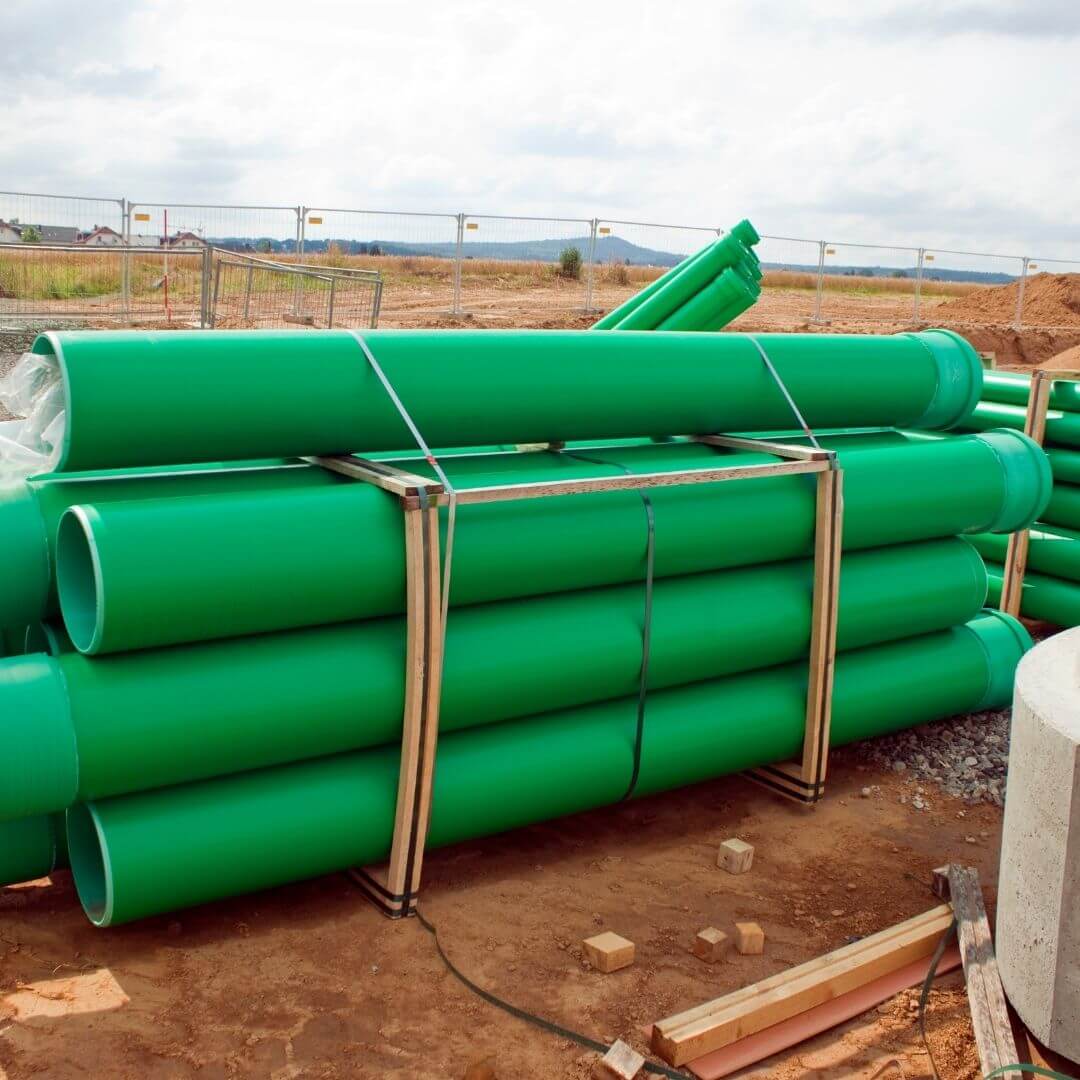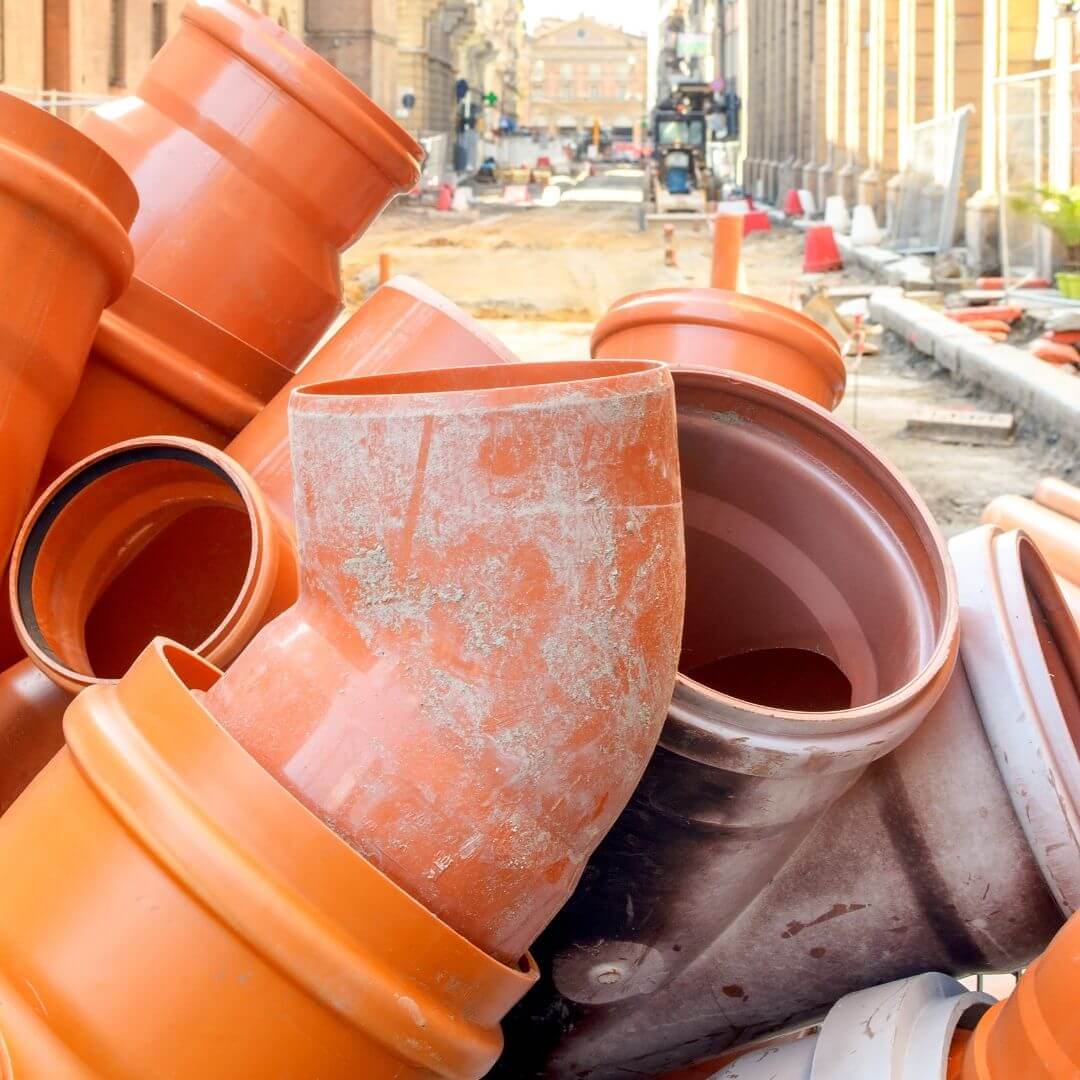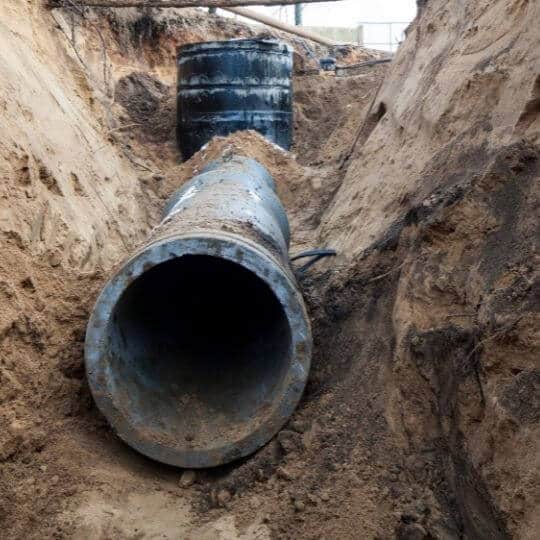Every aspect of building and installing systems within our home deserves extra attention. Without that added care it’s possible to end up with a much worse system that can easily malfunction later down the line. Among the concerns we should take into account, different types of sewer pipes and which ones we install are high on the list. Malfunctioning ones can be rather pricey to repair and can even operate in a much worse capacity, so let’s dive into it and see what can be improved.
Types of Sewer Pipes: Material

The biggest distinguishing factor in household sewer installations is the types of sewer pipe materials that we use. These can alter the strong points of our sewer system, so it’s fruitful to check them out.
While some may be outdated and there are better options, knowing about them can be useful. After all, if the installations need fixing or small expansions it may be unwise to switch the type of material used.
PVC
With the installation of sewer pipes, there are constant changes in the most popular and potent materials. The types of sewer pipe material also have different properties.
The PVC pipes are rather smooth and they have very good resistance to different forms of stress. The PVC plastic works great with its smooth interior, allowing the waste to flow much better than usual. This extra flow of waste reduces potential problems throughout the pipe.
Outside of it, the exterior provides a very potent way to resist the unfortunate problem of roots burrowing into our pipes. The root anchorage is a lot less likely with PVC pipes than with some other types of pipes.
However, this is not all that PVC pipes can offer. They are also extremely lightweight, which makes them much easier to transport. Cutting these pipes is also not too difficult of a task, requiring nothing but a saw. Don’t let it deceive you though, that ease of cutting doesn’t mean the resilience is compromised in any way.
Although, if you want to enhance the robustness of your sewer system even further, you can combine them with other pipes. It’s worthwhile to note that PVC pipes are an inexpensive solution for sewer installations. On top of the previously mentioned benefits, the combination of lightweight nature, inexpensiveness, and ease of cutting makes them very good for people who are keen on DIY projects.
ABS
In a similar line of plastic pipes such as PVC, ABS pipes hold quite a bit of sway in terms of preferred pipe choices. The ABS pipes do differ from their PVC counterparts somewhat though. The ABS pipe is stronger than the PVC one, although that advantage does come at a cost of flexibility. They also connect in two different ways which do end up being quite impactful.
We are able to retain the positives of PVC with ABS. The lightweight nature and ease of cutting are still there despite the pipes being more formidable. Smooth interiors and exteriors manage to provide a good experience for our overall waste management. Sewer installation’s potency is important so it’s good to go for something that covers all bases such as this pipe type.
Cast-Iron
In terms of sewer pipes, this is one of the heaviest. The cast-iron pipes are a classic when it comes to sewer pipes. They are traditional pipes you may recognize from usual depictions of pipes and have rather formidable composure. The pipes also have a lifespan of about 25 years although they can be heavily affected by other factors like rust.
The cast-iron pipes do have problems with rust so making sure they are properly protected against it is key to a good experience with them. You should also make sure to maintain pipes, to clear out the rust. Cast-iron pipes are present in multiple sizes and have different thicknesses depending on the type.
Clay
With clay pipes, we get an alternative to standard plastic pipes. Clay pipes are available for both open and closed systems. The clay pipes have certain weaknesses. They don’t do well in areas that have a lot of land shifting. If you are installing them we recommend checking how much land shifts around your household because it could affect their longevity.
Types of joints in sewer pipes

Another difference between sewer installations comes from the joints they connect through. With every joint type, there are specific strengths and weaknesses. The joints also fit different types of pipes better and are paramount to expanding the existing system. [1]
Bell and spigot joint
The joints in pipes are used to connect separate parts of pipes into one whole. Joints that are used for concrete and reinforced concrete pipes are usually those of the bell and spigot variety. The pipe has two different ends.
One being a bell and the other a spigot. These sides are used as a way to properly insert the cement pipes between the two points. Resulting in a much tighter pipe installation and a safer connection.
These are some of the most common joints when it comes to pipes and they have warranted that position with overall effectiveness. They are really tough and easy to install on top of showcasing potent performance. The joint also has the advantage of being rather economical as far as choices for steel water pipes go. [2]
Collar joints
When the joints in a sewer need to be tied for longer consecutive lengths and are near each other, we end up going for a collar joint. The collar joint is rather large in diameter, being slightly bigger than the diameter of the pipes we are supposed to use them for. The pipes are slotted inside of the joints, making it feel like a snug covering fit for the pipe.
To reiterate, these joints are frequently used for pipes of large diameters because other forms of enveloping them may be too costly. Similarly so, the large diameter may cause way more strain to the pipe’s joints which is why joints like this are utilized.
Simplex joints
Next up are simplex joints. These joints are referred to as ring tie coupling as well and share some common aspects with collar joints. Simplex joints still contain a pipe sleeve but this can also be a coupling that’s made out of asbestos cement.
For the sake of flexibility, these joints have rubber rings that are compressed between the sleeve and the pipe. With these joints, we achieve better flexibility while not compromising the integrity of links between pipes.
Flexible joints
Speaking of flexible joints, they are also a type of joint. These joints are also referred to as bituminous joints, this name stems from their composition. Instead of using cement mortar, flexible joints utilize bitumen which gives them extra flexibility. With these joints, we can mitigate the damage that comes from the movement of cement pipes.
Mind you, the potential damage kicks in with pipes settling into the ground so it will come into effect eventually. Regular collar joints usually have the side effect of making the construction too rigid which makes the pipes crack even easier.
Mechanical joints
The next type of joint is on the heavy-duty side. Mechanical joints are very formidable joints usually used for cast iron and steel sewers. These joints are reinforced with mechanical devices to reaffirm durability. Bolts, screws, and flange rings are frequently
Open joints
The open joints are yet another type of joint available for sewers. These joints have a pretty simple approach. Both their bell and spigot ends are put together without extra material to fill them in.
Open joints sometimes have gaskets inserted into them in order to maintain alignment but other than that, they are pretty simple in design. The only other form of extra engagement with them is tar paper that the joints get covered in. [3]
Types of Sewer Pipes : Sanitary

With the available types of sanitary pipes, we’ve showcased a decently wide span of choices for everybody. Make sure to gauge what you need. As we’ve shown above, the difference between materials makes the most difference between pipes.
These differences will be very present and important especially as time goes on. The more time passes the more noticeable the difference between types of pipes becomes.
With the older homes, we can usually expect clay and cast iron pipes to be present. With more modern systems we are most likely going to end up with PVC pipes. [4]
Conclusion
Going over all the types of sewer pipes shows us that there are different features of the pipe to take into account. Some may be inexpensive and fruitful but have a hard time dealing with specific areas, like clay pipes. While others represent a good option wherever, such as PVC pipes.
With the broad choice of materials, we are able to further customize our installation to fit our needs. Whether it’s a concern of durability or the flow of waste, we can optimize the system to work as we wish.
When it comes to trenchless repair you should pay extra attention to how to repair items depending on the type of materials and joints you use. Hopefully, with the extra sources of knowledge online you’ll be ready to tackle just about any problem. Whether it’s DIY or professional repairs, it’s good to be at the top of your game.

Michael Davis is a heating & plumbing expert who currently works as independent contractor in SC. He also writes for Plumbertip.
For almost 10 years he worked on various plumbing tasks across South Carolina.



